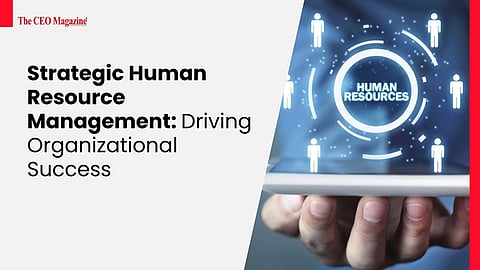
- News
- Women
- Magazine
- IndustryIndustry
- InsightsInsights
- Success Stories
- PublishPublish
- ContactContact
- Media KitMedia Kit

Strategic Human Resource Management: Driving Organizational Success
Strategic Human Resource Management (SHRM) is a critical function that aligns the goals of an organization with its workforce management practices. In today’s competitive business environment, HR departments are no longer just administrative support but play a pivotal role in driving organizational success by strategically managing the most valuable asset—people. In this article, we’ll explore the concept of SHRM, its benefits, and how companies can implement effective HR strategies to gain a competitive edge.
Strategic Human Resource Management refers to the proactive management of people. It’s about anticipating an organization's future needs concerning human capital and aligning the HR strategy with the overall business strategy. SHRM integrates HR practices such as recruitment, training, performance management, and employee relations into the company’s long-term goals.
Unlike traditional HRM, which tends to be reactive and focused on day-to-day operations, SHRM is forward-thinking, ensuring that the organization has the right talent, skills, and workforce structure to meet future challenges.
Talent Acquisition and Retention: The ability to attract and retain the right talent is crucial for SHRM. This involves not only hiring people with the right skills but also ensuring they align with the company’s culture and long-term objectives. Competitive compensation, career development opportunities, and a positive work environment are key factors in retaining top talent.
Performance Management: SHRM requires a strategic approach to evaluating and improving employee performance. Organizations need to set clear expectations, provide ongoing feedback, and align individual goals with business objectives. Performance management systems are critical to ensuring that employees contribute effectively to organizational success.
Learning and Development: The continuous development of employees is an essential component of SHRM. Upskilling and reskilling employees to adapt to industry trends and new technologies can give companies a competitive edge. A robust learning and development strategy helps in closing skill gaps, enhancing employee engagement, and preparing the workforce for future challenges.
Employee Engagement and Culture: A strategically managed workforce is highly engaged and motivated. SHRM promotes a culture that aligns with the company’s mission and values, fostering employee satisfaction and higher productivity. Building a positive work environment, recognizing achievements, and promoting open communication are key strategies to enhance employee engagement.
Succession Planning: SHRM includes succession planning to identify and develop future leaders within the organization. This ensures that critical roles are filled by capable individuals who are prepared to lead the company in achieving its long-term goals. Succession planning also helps in mitigating risks associated with leadership transitions.
Diversity and Inclusion: A strategic approach to diversity and inclusion (D&I) helps create a workforce that reflects the society the organization serves. D&I initiatives ensure that different perspectives are integrated into decision-making processes, fostering creativity and innovation. A diverse workforce also improves employee morale and broadens the company's appeal to a wider customer base.
Improved Organizational Performance: Companies with a strong SHRM approach tend to perform better as their workforce is aligned with strategic business objectives. This alignment ensures that every employee is working towards the same goals, which enhances overall productivity and performance.
Enhanced Employee Satisfaction and Retention: When HR strategies are closely aligned with employee needs and company objectives, employees are more likely to be satisfied with their roles. High levels of employee satisfaction contribute to lower turnover rates, reducing the costs associated with recruiting and training new staff.
Competitive Advantage: Organizations that implement SHRM gain a competitive edge by having a highly skilled and engaged workforce. These companies can respond more effectively to market changes, innovate more quickly, and attract top talent, all of which contribute to their success.
Risk Management: SHRM allows organizations to identify and mitigate potential HR-related risks such as skill shortages, high turnover, and leadership gaps. With proactive planning and succession strategies, companies can minimize disruptions caused by unexpected changes in their workforce.
Flexibility and Adaptability: SHRM helps companies become more flexible and adaptable to changes in the business environment. Whether it's adopting new technologies, entering new markets, or responding to economic shifts, a strategically managed workforce can pivot quickly and efficiently.
Align HR with Business Goals: The first step in implementing SHRM is aligning HR practices with the overall business strategy. This requires HR leaders to be actively involved in the company's strategic planning process. HR should understand the company’s vision and goals, and then design policies that support these objectives.
Use Data-Driven HR Analytics: Leveraging HR analytics and data can help in making informed decisions about workforce planning, talent management, and employee performance. By analyzing trends in employee turnover, performance, and engagement, HR can develop strategies that are backed by data.
Invest in Technology: Utilizing HR technology such as Human Resource Information Systems (HRIS) and other HR software can streamline processes and improve efficiency. These systems help in automating administrative tasks, tracking employee performance, and facilitating talent management, allowing HR to focus on strategic initiatives.
Foster a Culture of Continuous Learning: SHRM emphasizes the importance of learning and development. Creating a culture where employees are encouraged to continuously improve their skills can help organizations stay competitive in an ever-changing market. Offering training programs, mentorship opportunities, and career development pathways are essential elements of SHRM.
Prioritize Employee Well-Being: A strategic approach to HR considers employee well-being as a core element of its success. Companies should invest in mental health programs, work-life balance initiatives, and wellness resources to ensure that their employees remain healthy, engaged, and productive.
Strategic Human Resource Management is more than just managing employees; it is about aligning the workforce with the organization's long-term goals to create a competitive advantage. By integrating HR practices into the overall strategy, organizations can drive performance, enhance employee satisfaction, and better prepare for future challenges. Companies that successfully implement SHRM are well-positioned to thrive in today’s dynamic business landscape.
Follow us on Google News
